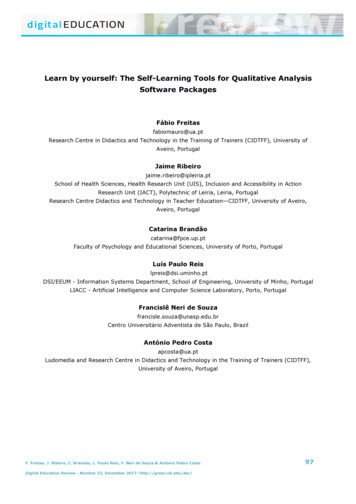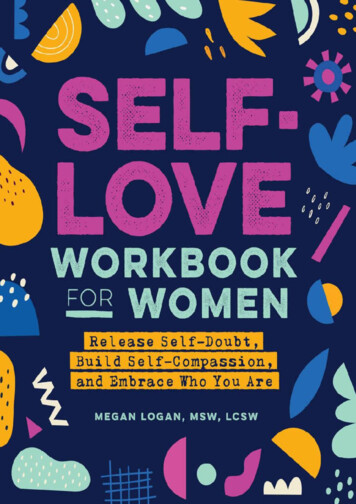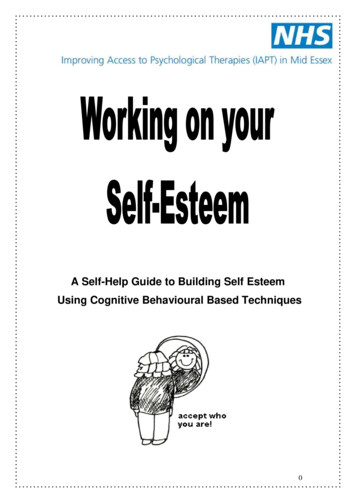
Transcription
Learn for Yourself: The Self-Learning Tools for Qualitative Analysis Software PackagesLearn by yourself: The Self-Learning Tools for Qualitative AnalysisSoftware PackagesFábio Freitasfabiomauro@ua.ptResearch Centre in Didactics and Technology in the Training of Trainers (CIDTFF), University ofAveiro, PortugalJaime Ribeirojaime.ribeiro@ipleiria.ptSchool of Health Sciences, Health Research Unit (UIS), Inclusion and Accessibility in ActionResearch Unit (IACT), Polytechnic of Leiria, Leiria, PortugalResearch Centre Didactics and Technology in Teacher Education—CIDTFF, University of Aveiro,Aveiro, PortugalCatarina Brandãocatarina@fpce.up.ptFaculty of Psychology and Educational Sciences, University of Porto, PortugalLuís Paulo Reislpreis@dsi.uminho.ptDSI/EEUM - Information Systems Department, School of Engineering, University of Minho, PortugalLIACC - Artificial Intelligence and Computer Science Laboratory, Porto, PortugalFrancislê Neri de Souzafrancisle.souza@unasp.edu.brCentro Universitário Adventista de São Paulo, BrazilAntónio Pedro Costaapcosta@ua.ptLudomedia and Research Centre in Didactics and Technology in the Training of Trainers (CIDTFF),University of Aveiro, PortugalF. Freitas, J. Ribeiro, C. Brandão, L. Paulo Reis, F. Neri de Souza & António Pedro CostaDigital Education Review - Number 32, December 2017- http://greav.ub.edu/der/97
Learn for Yourself: The Self-Learning Tools for Qualitative Analysis Software PackagesAbstractComputer Assisted Qualitative Data Analysis Software (CAQDAS) are tools that helpresearchers to develop qualitative research projects. These software packages help theusers with tasks such as transcription analysis, coding and text interpretation, writing straction,groundedtheorymethodology, discourse analysis, data mapping, and several other types of analysis. Thispaper focus the new paradigm of self-learning, that presents itself increasingly as acompetence to support learning in a proactive way. It further analyses education andCAQDAS with emphasis on the use of CAQDAS in educational research and the self-learningof CAQDAS. The study conducted had two main goals: (1) analyse the self-learning tools ofCAQDAS and (2) identify CAQDAS's users learning profile . Six software packages wereselected: NVivo, Atlas.ti, Dedoose, webQDA, MAXQDA, and QDA Miner. They werereviewed, taking into account their transversality, language, (self-learning) tools, amongother criteria. The results show that there is a considerable demand for information fromusers regarding the execution of processes in CAQDAS, and that the packages analysed donot guide users towards the self-learning tools that best fit their learning style.KeywordsComputer Assisted Qualitative Data Analysis Software; CAQDAS; Self-learning andEducation.F. Freitas, J. Ribeiro, C. Brandão, L. Paulo Reis, F. Neri de Souza & António Pedro CostaDigital Education Review - Number 32, December 2017- http://greav.ub.edu/der/98
Learn for Yourself: The Self-Learning Tools for Qualitative Analysis Software PackagesI.IntroductionSince the 1980s, the widespread availability of personal computers and the emergence of veenabledqualitativeandqualitativeinvestigations to be carried out with higher quality and depth. Methods of qualitative data analysishave been receiving increasing interest from researchers and practitioners in many areas. Amongother techniques, it is worth mentioning content analysis, that has received a prominence in theacademic community, allowing increasing the methodological rigor of studies conducted in theareas of social sciences, marketing research ethnography, public health, psychology, among manyothers.Currently there are more than fifty software packages available in the market that allow theanalysis of qualitative data (Saillard, 2011). Among these packages those that stand out are(Wikipedia, 2016): NVivo (QSR software, 2017; Wikipedia, 2017d), Atlas.ti (Atlas.ti, 2017;Wikipedia, 2017a), Dedoose (Dedoose, 2017; Wikipedia, 2017b), MAXQDA (MAXQDA, 2017;Wikipedia, 2017c) and webQDA (Neri-de-Souza, Costa, & Moreira, 2011; webQDA, 2017) for theirbroad use, general capabilities and functionalities or capabilities to enable collaborative work.These software packages also do not impose a specific methodological approach, giving theresearcher the liberty to select the research approach we wishes to use and to apply differentstrategies on the research.Although there is a large number of qualitative analysis software packages available, there is avery scarce effort on analyzing their potentialities in depth and a very small number of studiescomparing these potentialities (Silver & Lewins, 2007; University of Surrey, 2017; Wikipedia,20017). In addition, there are almost no works analyzing self-learning as a possible effectivemethod for learning Computer Assisted Qualitative Data Analysis Software and on how to turnnormal software users, or questions’ posers/executors, into authors of their own knowledge andparticipants in the content learning process as co-producers of learning support documents. Thus,this paper reviews the new paradigm of self-learning and its relation to CAQDAS with emphasis onthe use of CAQDAS for education research and the self-learning of CAQDAS tools.The rest of the paper is structured as follows. Section II reviews the new paradigm of self-learningand its relation with CAQDAS. Section III analyses education and CAQDAS with emphasis on theuse of CAQDAS in educational research and the self-learning of CAQDAS. Section IV describes themethodology for the study conducted that had as main goals to analyze the self-learning tools ofCAQDAS and identify CAQDAS's users profile regarding learning. Section V describes the mainresults achieved and the following section analyses the user’s preference on CAQDAS learning toolsand preferred methods to learn CAQDAS. Finally, section VII presents some concluding remarks.II. Self-learningWe live in times when people are increasingly encouraged to be autonomous in carrying out themost diversified tasks. An example of this is the fact that until very recently it was difficult toimagine that when going to a supermarket people would have to register themselves the purchasesmade or to supply one’s car at a fuel supply. This is the age of “do-it-yourself”, where people haveautonomy to achieve things that in the past required the intervention of others. As such, the abilityF. Freitas, J. Ribeiro, C. Brandão, L. Paulo Reis, F. Neri de Souza & António Pedro CostaDigital Education Review - Number 32, December 2017- http://greav.ub.edu/der/99
Learn for Yourself: The Self-Learning Tools for Qualitative Analysis Software Packagesto learn autonomously has become a basic ability, and is increasingly essential in today's world,making self-learning a necessity in the face of the demands of today's society. However, it isimportant to emphasize that learning to learn requires purpose, effort, discipline and responsibility,avoiding the preconceived idea of being a simplistic, easy and superficial learning process. Learningto learn proves to be an important avenue for progression and improvement of personal and socialwell-being (Lima Santos & Gomes, 2009).This new paradigm is also felt in the educational context, more specifically in the learning process,where students (especially those in the higher education levels) are encouraged to develop moreautonomous learning skills. In this way the student is challenged to identify a learning need, usingthe personal resources that he considers most effective, applying them in a systematic and flexibleway through his cognitive, social and creative capacities (Lima Santos & Gomes, 2009). Anexample of this is the emergence of higher education institutions that exclude the role of theteacher and promote collaborative learning, thus allowing students to develop autonomous learningsolutions supported by more creative methods (Matt Pickles, 2016).In this sense, self-learning presents itself increasingly as a competence to support learning in aproactive way. It is sustained by a great sense of responsibility and autonomy, in which the learnercreates and self-regulates his own learning path and selects the learning contents he intends toacquire, managing his learning process (Eranki & Moudgalya, 2016; Lima Santos & Faria, 2003,2007; Magalhães, 2011).Nevertheless, we may wonder about the real advantages that self-learning can have in the learningprocess. Some studies stress some of these advantages, first of all, at the level of cognitivecompetences. Self-learning appears to increase critical superior thinking and questioning skills(Candy, 1991); stimulate confidence and problem-solving ability (Durr, 1992); and promote a"deep learning" experience (Stansfield, 1997). On the other hand, regarding efficiency, there isevidence that self-learning contributes to a better performance in the execution of tasks (Merriam,Caffarella, & Baumgartner, 2007); to establishing a greater commitment to learning (Cho & Kwon,2008); and greater persistence in the face of obstacles and challenges(Zsiga, 2008).Methodological competences are also influenced by self-learning, by fostering the incentive to proactivity and autonomy (Lima Santos & Faria, 2003, 2007); as well as in the promotion ofcollaborative knowledge networks (Rowland, Frances; Volet, 1996).In addition to being a method by which the student can achieve knowledge, learningindependently, self-learning also gives the possibility of an active, free learning that stimulatesresponsibility and respects the student’s learning pace (Rurato, 2008). Thereby, the student takesthe initiative to manage his own learning process, harmonizing the knowledge according to hisneeds, personally valuing his own training (Rurato, 2008). In this sense, the levels of highresponsibility inherent in self-learning seem to make this process more suitable for young adultsand adults, than for children or adolescents, since these, by their natural immaturity may manifestlittle capacity for self-discipline in their learning process. Therefore, it will be expected that selflearning will find in the context of higher education, an environment more conducive to itsapplicability, since it is a learning context less structured and with fewer limitations than otherteaching contexts (Moreira, Nejmeddine, & Almeida, 2014).F. Freitas, J. Ribeiro, C. Brandão, L. Paulo Reis, F. Neri de Souza & António Pedro CostaDigital Education Review - Number 32, December 2017- http://greav.ub.edu/der/100
Learn for Yourself: The Self-Learning Tools for Qualitative Analysis Software PackagesHowever, it is in the online context that the term self-learning more often arises, since theseenvironments are very adaptable to the characteristics of self-learning by proposing a broader andmore flexible model, thus enabling a variety of modalities of conduction of the learning process(Alonso, Lopez, Manrique, & Vines, 2005). Studies show that virtual environments, based on adesign focused on the development of competences, on the principles of constructivism, autonomyand interaction, have very positive effects on learning competences, such as active learning,learning initiative and Autonomy in Learning (Costa & Moreira, 2013).However, are there prerequisites or innate skills for self-learning? According to Moreira,Nejmeddine and Almeida (2014), for an efficient process of self-learning it is required from thestudent (mainly in the context of higher education) a high level of self-regulation in order to moreeffectively manage his/her learning process. Regarding the innate tendency for self-learning, thereare important areas of research within adult education area that have focused on identifying andmeasuring their propensity for adopting self-learning methodologies, such as the “self-directedlearning readiness” (Guglielmino, 1977). In addition, other authors identify four antecedents thatmay influence adult students in the use of self-learning. These are (i) the existence of innatepsychological traits that favor autonomous learning; (ii) the possession of technical skills for selflearning; (iii) familiarity with the subject being studied; and (iv) motivation to initiate, continue andcomplete the autonomous learning process (Brockett & Hiemstra, 1991; Candy, 1991; Merriam etal., 2007).Based on all these concepts, it is likely that self-learning may be one of the most effective methodsfor learning Qualitative Data Analysis Software (QDAS). However, the challenge is to understandhow to turn software users, or executors of questions, in authors of their own knowledge. CanCAQDAS’s users become participants in the content learning process as co-producers of learningsupport documents?The reality is that the use of digital tools to support data analysis requires a high technical andmethodological knowledge on the part of the researcher. These requirements may sometimes bedemotivating. This is especially relevant if we take into account that a considerable number ofresearchers who use qualitative analysis software packages do so in the framework of theirmasters and doctoral or postgraduate projects (Freitas, Neri de Souza, & Costa, 2016; Silver &Rivers, 2015), so there is no great time available for learning software. However, the requirementsintrinsic to the development of qualitative research (such as the diversity of research contexts,variety of formats, quantity and types of data, etc.) may turn the use of self-learning tools asolution to decrease the learning curve of these applications (Martin, Mitrovic, Koedinger, &Mathan, 2011). In this way, the researcher would reduce the time spent in learning, and add it tohis/her productivity.III. QDAS)inEducationWhen we address education and CAQDAS, two thoughts arise: i) the use of CAQDAS in educationalresearch and ii) the learning of CAQDAS. We will try to cover both to enlighten the reader.As can be read in this paper CAQDAS came to revolutionize how data analysis is done in qualitativeresearch. They contribute greatly to the rigor and credibility of qualitative research carried out.F. Freitas, J. Ribeiro, C. Brandão, L. Paulo Reis, F. Neri de Souza & António Pedro CostaDigital Education Review - Number 32, December 2017- http://greav.ub.edu/der/101
Learn for Yourself: The Self-Learning Tools for Qualitative Analysis Software PackagesNowadays it's assumed that qualitative research will be hampered when dedicated software is notused, for example in the technique of content analysis, perhaps the most used in this researchapproach, the use of general productivity tools will not impede the data interpretation, but it can beimproved with a software designed specifically to maximise this process (Freitas, Ribeiro, Brandão,Souza, Costa & Reis, 2018; Bardin, 2013).As known, qualitative research was boosted by social sciences although it is currently transversal toseveral scientific areas (Chizotti, 2006). One of those areas is education, area of interest of societyin general and in particular of those directly involved, who seek to know the whys, who want to domore and better and, above all, to perceive the uniqueness of the phenomena in its socioeconomic,temporal and physical contexts. The education of students and teacher training move severalresearches, which often take the form of case study or action research (Nath, 2005).These research designs produce a massive amount of raw data such as interviews, focus groupsand observation, that require rigorous and in-depth analysis, which can even be achieved manuallyin the hands of an experienced researcher. However, in the vast amount of research that pursue anacademic title, certainly will only be achieved resorting to facilitating tools such as CAQDAS(Ribeiro, Brandão & Costa, 2016; Costa, Faria & Reis, 2016). Manual processing can be combinedwith CAQDAS, which provides a closeness with the data that leads to the development of credibleand defensible conclusions (Souza, Costa & Souza, 2015).A basic justification for using CAQDAS is their ability to optimize data reduction, easy coding andenhanced ability to access and explore the data and the analysis made (Reis, Costa, & Souza,2016). There is a perceived swiftness, preciseness and effortlessness afforded by the simpleclicking, dragging of context and registry units into categories and, accessing their original sourcesin CAQDAS such as webQDA, compared to paper pencil and highlighters, and even withspreadsheets or word processor tables.Appropriating the words of Sohn (2017, n.p.) we alsoconsider “Getting bogged down in quantities and the nitty gritty details of coding can takeunnecessary time and effort, and can prevent the researcher from gaining a sense of the whole ofa phenomenon”. Nevertheless, it must be beard in mind that, as experienced researchers know, nosoftware program will do the analysis automatically and that it is a non-delegable task, requiringthe constant proximity of the researcher.Software packages dedicated to qualitative research support can enable:1.organization of the data collected (particularly when dealing with a high volume of data);2.systematization and analysis of data;3.definition of analysis dimensions, categories and subcategories;4.visual modelling and representation of concepts and theories in the research.Although the use of software makes it possible to improve processes in response to researchquestions, it does not replace the analytical competence of researchers. It should not automaticallyinterfere with the actions and reflections of the qualitative analysis, observing that the rigor andquality obtained will be truly achieved with the adherence to criteria defended in the literature forthe conduction of a qualitative approach (Costa, Souza, & Reis, 2015).F. Freitas, J. Ribeiro, C. Brandão, L. Paulo Reis, F. Neri de Souza & António Pedro CostaDigital Education Review - Number 32, December 2017- http://greav.ub.edu/der/102
Learn for Yourself: The Self-Learning Tools for Qualitative Analysis Software PackagesAdvantages in Adopting CAQDASLimitations on Adoption of CAQDASIt allows approaches of different methods, such asCAQDAS packages are very complex;mixed methods.need a lot of time and effort to know thespecific features and functions.Speed and consistency in data analysis.Dictionaryentries/categoriesnotsufficient for language-in-context.Structured outputs and feedback of analyzed dataLimitedautomatedcoding(word, phrase, category, code count, matrix, searchManual encoding required.processes;etc.)Codes can be organized hierarchically and modifiedAnalysis of in-depth content (semanticand mobilized during coding and analysis. Possibilityanalysis) hardly possible with large data.of crossing and overlapping codes of the most infiniteforms.The inter- and intra-coder reliability tests can beMostCAQDASareperformed.somewhat expensive.paidleaveandTable 1. Presents pros and cons of CAQDAS use.Adapted from: (Einspänner, Dang-Anh, & Thimm, 2014)Returning to the specific use of CAQDAS in education, we call attention to the use of software as apedagogical tool for learning the process of data analysis of qualitative research. Most of this paperauthors are lecturers and have realized how they could blend the learning of data processing withthe learning of dedicated software, observing greater ease on the part of the students in theunderstanding of the theory and process of qualitative data analysis. This thought was alreadyaddressed in 2003 by Walsh (and probably by many others) who saw that with the use of QDA“The coding system is a way of labeling certain aspects of your data and sorting the information intodistinctive categories. It is an easy way of keeping track of your ideas as well as documents aboutspecific topics. Coding lets you use words, phrases, and ideas directly from the text and you can, captureinformation about things (such as how someone was feeling, when something happened) and explorethem further when you decide it’s time.” (p.254)This paraphrase illustrates not only the contact of students with a CAQDAS functionalities, but alsowith the process of exploring and analyzing the data itself.Whereas, Holbrook and Butcher in the early 1996, alert for the diversity of backgrounds of theresearchers, particularly education researchers and the need for previous research methodslearning before contacting with CAQDAS.Julius (2012) points out that there is more to learn that only its processes and technical issues. Inhis review, he highlights that it is also to know how the used research methodology relates to thetools the software has. The author also states that it may be useful to combine software learningwith the learning of research methodologies, but it requires changing teaching practices, whichshould be more reflexive and wherever possible associated with student research projects.F. Freitas, J. Ribeiro, C. Brandão, L. Paulo Reis, F. Neri de Souza & António Pedro CostaDigital Education Review - Number 32, December 2017- http://greav.ub.edu/der/103
Learn for Yourself: The Self-Learning Tools for Qualitative Analysis Software PackagesIV. MethodologyThis study has two goals: (1) to analyse the self-learning tools of Qualitative Data AnalysisSoftware; and (2) to identify CAQDAS's users learning profile.With regard to the first objective, it was adopted a methodology that favoured the identification,registration and analysis of CAQDAS tools related to the self-learning process. Six softwarepackages were selected: NVivo, Atlas.ti, Dedoose, webQDA, MAXQDA, and QDA Miner. They werethen reviewed, taking into account, among other criteria, their transversality in terms of: operatingsystems; type of access (Desktop or Web); language in which they are available; and typology oflicenses. Considering (self-learning) tools, the offers available for the various packages wereanalysed with regard to: User Manual; Methodological Manual; Tutorial Videos; Frequently AskedQuestions (FAQs); Forum; Blog; Training; Workshops; Webinars; Consulting; or other tools. Thesedata were identified through a systematic search in the software’s websites.In a second phase, and with the aim of complementing the revised data, attention was focused onone of the self-learning tools - the forums. It was conducted a corpus analysis of the internet data(Hewson, Yule, Laurent, & Vogel, 2003; Neri de Souza & Almeida, 2009) with the objective ofcarrying out a second analysis of the data existing in the forums of the various software packages.Given the large volume of data corpus existing in these forums, it was decided - for a bettersystematization - to only analyse the topics regarding the last month prior to this study.A total of 114 messages from users, trainers, moderators, authors of user manuals and technicalsupport of the forums of the packages were analysed. Of these 114 messages, 62 belonged toNVivo, 25 to Atlas.ti, 12 to webQDA, 11 to MAXQDA and four to QDA Miner. Dedoose forummessages were not analysed since it was disabled at the time of the IssuesType entsAllusive to all questions related to doubts for the execution of acertain action or process in the course of using the softwareConcerning doubts regarding the sequence of actions (codification,matrixes, functionalities, etc.) more appropriate to specificprojectsConcerning all questions associated with anomalies (system bugs,etc.) arising from the execution of operationsTable 2. Dimension and Categories Analysis of forums.In Table 2 we can see the dimensions and categories analysis of forums. In dimensanalysis of thelatent data of the Internet, three areas were focused: i) the typology of questions posed by users;ii) answers with instructions from the trainers, moderators, technical support or authors of usermanuals; and iii) suggestions for improvement, referenced by users, to be introduced in theanalysed packages.F. Freitas, J. Ribeiro, C. Brandão, L. Paulo Reis, F. Neri de Souza & António Pedro CostaDigital Education Review - Number 32, December 2017- http://greav.ub.edu/der/104
Learn for Yourself: The Self-Learning Tools for Qualitative Analysis Software PackagesRegarding the typology of questions posed by users, three categories were defined (Table 2): i)"Executive Issues", allusive to all questions related to doubts regarding the execution of a certainaction or process in the course of using the software; ii) "Methodological Issues", concerningdoubts regarding the sequence of actions (codification, matrixes, functionalities, etc.) more suitableto specific projects; and finally (iii) "Technical Issues", concerning all questions associated withanomalies (system bugs, etc.) arising from the execution of operations.Regarding the second area focused, the answers to the questions asked in the forums, theinstructions given were considered, and if the questions were answered in the forum itself or if theyreferred to other sites. Collaborative answers were also analysed, that is, the answers given byusers in support of questions posed by other users as opposed to forum moderators or technicalsupport elements.Finally, regarding the third area focused in the analysis of the latent data of the Internet, some ofthe messages that contained proposals for improvements were analysed considering: i) usability;ii) support; iii) instructional clarity; and iv) technical matters. The "usability" proposals refer to theimprovements needed for a more efficient use of the software, while the suggestions of "support"concern the need for improvement in the support to the users. "Instructional clarity" is related toimprovements in the instructions (text or figures) of the steps to be performed, whilst "technicalissues" point to functionalities, or technical procedures, which the software should provide. Theanalysis of the suggestions messages in the forums was aimed at understanding the needs of userswho were not effectively answered by the self-learning tools provided by the various packages.The analysis of the messages of the forums was based on the collection from the consideredforums, later placed and organized in a CAQDAS software, where they were qualitatively analysed.Regarding the second objective of the study, the identification of CAQDAS's users learning profile,an online questionnaire was applied, using Google Forms. The questionnaire was validated by fourresearchers from the area of educational technologies and two users of CAQDAS. It consists of 29questions grouped into five areas: i) characterization of the respondents; ii) characterization of theCAQDAS package they use; iii) learning habits of CAQDAS; iv) usability and user experience ofCAQDAS (self)learning tools; and v) usability expectations in a CAQDAS (self)learning platform. Forthis study only the answers to the questions regarding the learning habits of CAQDAS were takeninto account.The sample is composed of 114 users from different parts of the world, using different CAQDASpackages. Fifty four per cent of respondents (n 62) were women and 46% men (n 52). In termsof ages, 16% (n 18) were between 20-30 years, 38% (n 43) between 31-40 years, 29% (n 33)between 41-50 years, 16% (n 18) between the ages of 51-60 years and 1% (n 2) between 61and 80 years. As to the level of academic education, 43% (n 49) are conducting a PhD, 30%(n 34) hold a PhD, 9% (n 11) hold postdoctoral studies, 4% (n 5) are conducting postdoctoralstudies, 3% (n 3) hold a degree and another 3% (n 3) are taking a master's degree.In the next two sections, the results regarding the study’s goals are presented.F. Freitas, J. Ribeiro, C. Brandão, L. Paulo Reis, F. Neri de Souza & António Pedro CostaDigital Education Review - Number 32, December 2017- http://greav.ub.edu/der/105
Learn for Yourself: The Self-Learning Tools for Qualitative Analysis Software PackagesIV. Self-Learning tools of Qualitative Data Analysis Software PackagesIn the current context of rapid technological progress and commercial competition, CAQDASpackage developers look at the technical capabilities of their competitors, seeking to integratethem (adapting and refining) into new versions of their software (Gregorio, 2011). Hence, currentsoftware packages do not greatly differ regarding the level of the functionalities that they deliver.The biggest contrast between CAQDAS packages may be essentially the cost of licenses and thedifficulties associated with usability and learning (Pinho, Rodrigues, Souza, & Lopes, 2014).Table 3 presents, in a general way, the list of existing self-learning tools in the six analysedpackages, considering the latest versions of the applications at the date of this study. In thefollowing sections the tools analysed are discussed in terms of their function and assistance in thevarious CAQDAS packages, with a more extensive exploration of the data collected from er- Quick Use- UserManualUser Manual(Paper,PDF andHTML)- Quick Use- UserManual (PDF)Manual- User Manual(HTML;(PDF)PDF)Manual- Manual de(PDF);UserUtilização Rápida- UserManual(PDF)Manual(PDF)(HTML,PDF)Methodological -- - - FAQs - Forum - *Blog Training - Workshops - (free) (free) - ManualsVideoTutorialsWebinarsConsulting Resources forOther Tools-methodology-classesMethodologicalE-books (free) MAXQDAAnalytics-Pro* Available only in a LinkedIn closed groupTable 3. List of self-learning tools in the analysed CAQDAS packages (Freitas et al., 2017).a. User Guides and Methodological GuidesAccording to the analysis made, it is possible to verify, as it would be expected, that all thepackages provide a manual to the users. The User Manual turns out to be one of the resources thatthe users most resort to in
selected: NVivo, Atlas.ti, Dedoose, webQDA, MAXQDA, and QDA Miner. They were reviewed, taking into account their transversality, language, (self-learning) tools, among other criteria. The results show that there is a considerable demand for information from users regarding the execution of processes in CAQDAS, and that the packages analysed do .











